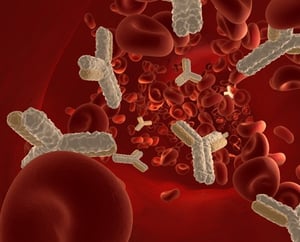 When it comes to labeling your antibodies for downstream application requiring signal detection, you have two choices. You can either go for the direct approach or the indirect approach. How do you know which method to use? Here are some things you need to know to make sure you pick the right method for the intended application.
When it comes to labeling your antibodies for downstream application requiring signal detection, you have two choices. You can either go for the direct approach or the indirect approach. How do you know which method to use? Here are some things you need to know to make sure you pick the right method for the intended application.
Direct Antibody Labeling Method
The direct labeling method is a simple technique that can be used for detecting highly expressed antigens. In this method, the main antibody is conjugated to a label (e.g., HRP, AP, or fluorochrome) so there is no need for a secondary antibody. This means that since the primary antibody is doing all the work, you don’t need to perform any additional incubation and washing steps. The direct detection method also offers great flexibility in designing multicolor experiments, thanks to the wide range of fluorochromes available in the market today.
When should you use the direct antibody labeling method?
Consider using this method when:
- There is a high risk of the secondary antibody will not bind to anything specific.
- There is difficulty obtaining secondary antibodies (e.g., when working with non-standard organism primary antibodies).
- There is a need to get results quickly.
What are the limitations of the direct method?
Despite the apparent advantages the direct method has to offer, there are times when it is not ideally suited for your application. Here’s why.
- It is not as sensitive and versatile compared to the indirect methods.
- The label of the primary antibody may not be suitable for subsequent applications.
- There is a limited range of directly labeled primary antibodies so you may need to create one in the lab that suits the intended application.
Indirect Antibody Labeling Methods
While the direct labeling method is ideal for detecting highly expressed antigens, indirect labeling methods are perfect for applications involving antigens that are not expressed clearly. By using labeled secondary antibodies, you can achieve greater sensitivity due to the signal amplification resulting from the binding of multiple ancillary antibodies to the primary antibody.
What are the other advantages of the indirect method?
Aside from the increased sensitivity, indirect antibody labeling methods also offer the following advantages:
- The same secondary antibody can be used across different applications to validate target antigen detection.
- You can use any given secondary antibody with any primary antibody of the same type and host species, depending on the intended application. Alternatively, you can easily visualize your target protein by simply swapping the labeled secondary antibody that you are using.
- There is a wide range of available enzyme- and fluorophore-labeled secondary reagents.
Are there any disadvantages or limitations to the indirect method?
While a lot of good things can be said about this method, it is not suitable for all applications and may increase the non-specific binding of the secondary antibody. It also requires additional blocking steps and controls.
Common Antibody Labeling and Conjugation Methods
- NHS (Succinimidyl) Ester Method – a relatively simple method used to conjugate antibodies with fluorescent dyes. However, since NHS esters are extremely unstable and sensitive to moisture, you will need to use the labeled antibody immediately.
- Isothiocyanate Method – While this reagent may be more stable compared to NHS esters, reactions should be carried out at pH 9.5 or higher. Unfortunately, some monoclonal antibodies cannot withstand high pH values.
- Carbodiimide Method – uses carbodiimide reagents (e.g., EDC) to create covalent links between molecules containing amine and carboxyl groups. Carbodiimides are highly reactive, so they are ideal for antibodies with relatively inert materials.
- Two-tag Method – this method requires the antibody to be tagged prior to the attachment of a label.
- Periodate Method – commonly used to generate HRP-antibody conjugates. The periodate molecules in the reagent activate HRP by reacting with the carbohydrate chains to create aldehyde groups which then react with the lysine residues in the antibody molecules.






